This is an alphabetical list of plants used in herbalism.
Phytochemicals possibly involved in biological functions are the basis of herbalism, and may be grouped as:
For example, some secondary metabolites are toxins used to deter predation, and others are pheromones used to attract insects for pollination. Secondary metabolites and pigments may have therapeutic actions in humans, and can be refined to produce drugs; examples are quinine from the cinchona, morphine and codeine from the poppy, and digoxin from the foxglove.
In Europe, apothecaries stocked herbal ingredients as traditional medicines. In the Latin names for plants created by Linnaeus, the word officinalis indicates that a plant was used in this way. For example, the marsh mallow has the classification Althaea officinalis, as it was traditionally used as an emollient to soothe ulcers.Pharmacognosy is the study of plant sources of phytochemicals.
Some modern prescription drugs are based on plant extracts rather than whole plants. The phytochemicals may be synthesized, compounded or otherwise transformed to make pharmaceuticals. Examples of such derivatives include aspirin, which is chemically related to the salicylic acid found in white willow. The opium poppy is a major industrial source of opiates, including morphine. Few traditional remedies, however, have translated into modern drugs, although there is continuing research into the efficacy and possible adaptation of traditional herbal treatments.
A
| Scientific name
|
Common name
|
Description
|
Picture
|
|
Acacia senegal
|
Gum arabic
|
A natural gum sourced from hardened sap of various species of acacia tree used in ancient birth control as well as a binder and emulsifier for medicinal compounds. |

|
|
Achillea millefolium
|
Common yarrow
|
Purported to be a diaphoretic, astringent,tonic, stimulant and mild aromatic.
|

|
|
Actaea racemosa
|
Black cohosh
|
Historically used for arthritis and muscle pain, used more recently for conditions related to menopause and menstruation. |

|
|
Aesculus hippocastanum
|
Horse chestnut
|
Its seeds, leaves, bark, and flowers have been used medicinally for many centuries for treating joint pain, bladder and gastrointestinal problems, fever, leg cramps, and other conditions. It may be useful for treating chronic venous insufficiency. The raw plant materials are toxic unless processed. |
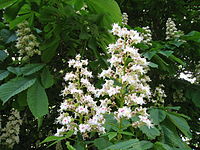
|
|
Ageratina altissima
|
White snakeroot
|
Root tea has been used to treat diarrhea, kidney stones, and fever. A root poultice can be used on snakebites. The smoke from burning leaves is used to revive unconscious people. The plant contains the toxin tremetol which causes milk sickness, a sometimes fatal condition. |
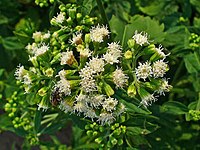
|
|
Alcea rosea
|
Common hollyhock
|
Believed to be an emollient and laxative. It is used to control inflammation, to stop bedwetting and as a mouthwash in cases of bleeding gums. |
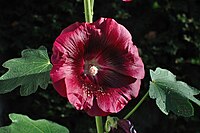
|
|
Alisma plantago-aquatica
|
Water-plantain
|
Used for the urinary tract. |
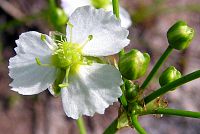
|
|
Allium sativum
|
Garlic
|
Purported use to lower blood cholesterol and high blood pressure. |

|
|
Aloe vera
|
Aloe vera
|
Leaves are widely used to heal burns, wounds and other skin ailments. |

|
|
Althaea officinalis
|
Marsh-mallow
|
Used historically as both a food and a medicine. |
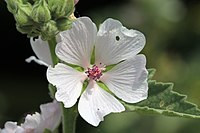
|
|
Amorphophallus konjac
|
Konjac
|
Significant dietary source of glucomannan, which is purported for use in treating obesity, constipation, and reducing cholesterol. |
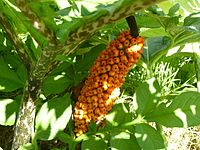
|
|
Anemone hepatica
|
Common hepatica
|
Historically used to treat liver diseases, it is still used in alternative medicine today. Other modern applications by herbalists include treatments for pimples, bronchitis and gout. |
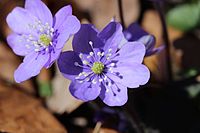
|
|
Angelica archangelica
|
Garden angelica
|
Roots have been used in the traditional Austrian medicine internally as tea or tincture for treatment of disorders of the gastrointestinal tract, respiratory tract, nervous system, and also against fever, infections, and flu. |
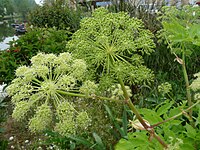
|
|
Angelica sinensis
|
Dong quai
|
Used for thousands of years in Asia, primarily in women's health. |
|
|
Apium graveolens
|
Celery
|
Seed is used only occasionally in tradition medicine. Modern usage is primarily as a diuretic. |
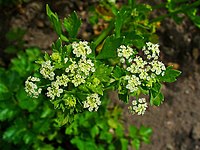
|
|
Arctium lappa
|
Burdock
|
Used traditionally as a diuretic and to lower blood sugar and, in traditional Chinese medicine as a treatment for sore throat and symptoms of the common cold. |

|
|
Arnica montana
|
Arnica
|
Used as an anti-inflammatory and for osteoarthritis. The US Food and Drug Administration has classified Arnica montana as an unsafe herb because of its toxicity. It should not be taken orally or applied to broken skin where absorption can occur. |
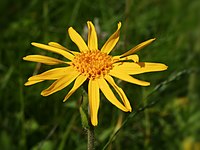
|
|
Astragalus propinquus
|
Astragalus
|
Long used in traditional Chinese medicine. |
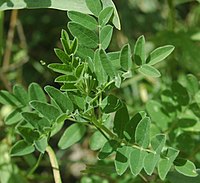
|
|
Atropa belladonna
|
Belladonna
|
Although toxic, was used historically in Italy by women to enlarge their pupils, as well as a sedative, among other uses. The name itself means "beautiful woman" in Italian. |
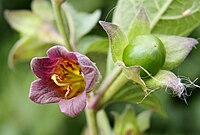
.
|
|
Azadirachta indica
|
Neem
|
Used in India to treat worms, malaria, rheumatism and skin infections among many other things. Its many uses have led to neem being called "the village dispensary" in India. |
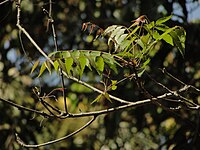
|
B
| Scientific name
|
Name
|
Description
|
Picture
|
|
Bellis perennis
|
Daisy
|
Flowers have been used in the traditional Austrian medicine internally as tea (or the leaves as a salad) for treatment of disorders of the gastrointestinal and respiratory tract. |
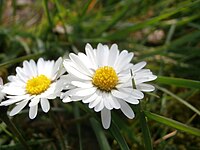
|
|
Berberis vulgaris
|
Barberry
|
Long history of medicinal use, dating back to the Middle Ages particularly among Native Americans. Uses have included skin ailments, scurvy and gastro-intestinal ailments. |

|
|
Borago officinalis
|
Borage
|
Used in hyperactive gastrointestinal, respiratory and cardiovascular disorders, such as gastrointestinal (colic, cramps, diarrhea), airways (asthma, bronchitis), cardiovascular, (cardiotonic, antihypertensive and blood purifier), urinary (diuretic and kidney/bladder disorders). |
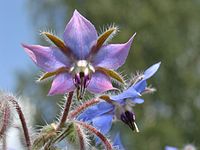
|
|
Broussonetia kurzii
|
Salae
|
Known as Salae in Thailand where this species is valued as a medicinal plant. |
|
C
| Scientific name
|
Name
|
Description
|
Picture
|
|
Calendula officinalis
|
Marigold
|
Also named calendula, has a long history of use in treating wounds and soothing skin. |
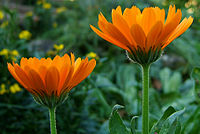
|
|
Cannabis
|
Hemp, Cannabis, Marijuana, Indian hemp, Ganja
|
Used worldwide since ancient times as treatment for various conditions and ailments including pain, inflammation, gastrointestinal issues such as IBS, muscle relaxation, anxiety, Alzheimer's and dementia, ADHD, autism, cancer, cerebral palsy, recurring headaches, Crohn's disease, depression, epilepsy, glaucoma, insomnia, and neuropathy among others. |
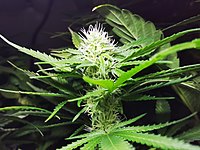
|
|
Capsicum annuum
|
Cayenne
|
Type of chili that has been used as both food and medicine for thousands of years. Uses have included reducing pain and swelling, lowering triglyceride and cholesterol levels and fighting viruses and harmful bacteria, due to high levels of Vitamin C. |
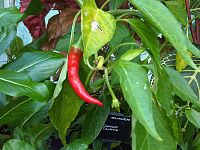
|
|
Capsicum frutescens
|
Chili
|
Its active ingredient, capsaicine, is the basic of commercial pain-relief ointments in Western medicine. The low incidence of heart attack in Thais may be related to capsaicine's fibronolytic action (dissolving blood clots). |

|
|
Carica papaya
|
Papaya
|
Used for treating wounds and stomach troubles. |
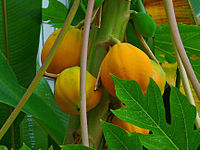
|
|
Cassia occidentalis
|
Coffee senna
|
Used in a wide variety of roles in traditional medicine, including in particular as a broad-spectrum internal and external antimicrobial, for liver disorders, for intestinal worms and other parasites and as an immune-system stimulant. |

|
|
Catha edulis
|
Khat
|
Mild stimulant used for thousands of years in Yemen, and is banned today in many countries. Contains the amphetamine-like substance cathinone. |
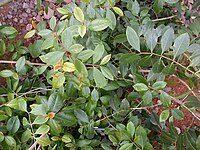
|
|
Cayaponia espelina
|
São Caetano melon
|
It is a diuretic and aid in the treatment of diarrhea and syphilis. |
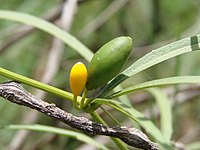
|
|
Centaurea cyanus
|
Cornflower
|
In herbalism, a decoction of cornflower is effective in treating conjunctivitis and as a wash for tired eyes. |
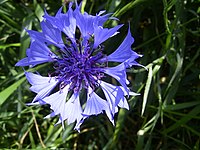
|
|
Chrysopogon zizanioides
|
Vetiver
|
Used for skin care. |
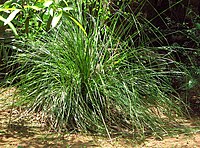
|
|
Cinchona spec.
|
Cinchona
|
Genus of about 38 species of trees whose bark is a source of alkaloids, including quinine. Its use as a febrifuge was first popularized in the 17th century by Peruvian Jesuits. |

|
|
Citrus × aurantium
|
Bitter orange
|
Used in traditional Chinese medicine and by indigenous peoples of the Amazon for nausea, indigestion and constipation. |

|
|
Citrus limon
|
Lemon
|
Along with other citruses, it has a long history of use in Chinese and Indian traditional medicine. In contemporary use, honey and lemon is common for treating coughs and sore throat.
|

|
|
Citrus trifoliata
|
Trifoliate orange, bitter orange
|
Fruits of Citrus trifoliata are widely used in Oriental medicine as a treatment for allergic inflammation. |

|
|
Cissampelos pareira
|
Velvetleaf
|
Used for a wide variety of conditions. |
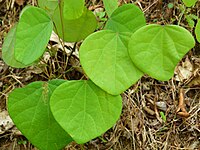
|
|
Cnicus benedictus
|
Blessed thistle
|
Used during the Middle Ages to treat bubonic plague. In modern times, herbal teas made from blessed thistle are used for loss of appetite, indigestion and other purposes. |
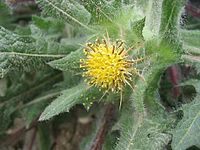
|
|
Crataegus monogyna and Crataegus laevigata
|
Hawthorn
|
Fruit has been used for centuries purportedly for heart disease, digestive and kidney related problems. |

|
|
Curcuma longa
|
Turmeric
|
Spice that lends its distinctive yellow color to Indian curries, has long been used in Ayurvedic and traditional Chinese medicine to aid digestion and liver function, relieve arthritis pain, and regulate menstruation. |
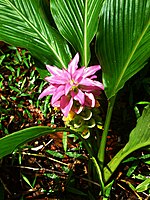
|
|
Cypripedium parviflorum
|
Yellow lady's slipper
|
The Cypripedium species have been used in native remedies for dermatitis, tooth aches, anxiety, headaches, as an antispasmodic, stimulant and sedative. However, the preferred species for use are Cyp. parviflorum and Cyp.acaule, used as topical applications or tea. |
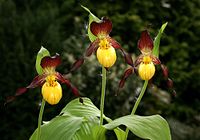
|
D
| Scientific name
|
Name
|
Description
|
Picture
|
|
Digitalis lanata
|
Digitalis or foxglove
|
It came into use in treating cardiac disease in late 18th century England in spite of its high toxicity. Its use has been almost entirely replaced by the pharmaceutical derivative Digoxin, which has a shorter half-life in the body, and whose toxicity is therefore more easily managed. Digoxin is used as an antiarrhythmic agent and inotrope. |
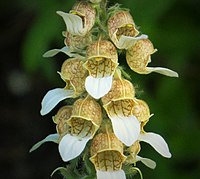
|
E
| Scientific name
|
Name
|
Description
|
Picture
|
|
Echinacea purpurea
|
Purple coneflower
|
This plant and other species of Echinacea have been used for at least 400 years by Native Americans to treat infections and wounds, and as a general "cure-all" (panacea). It is currently used for symptoms associated with cold and flu. |
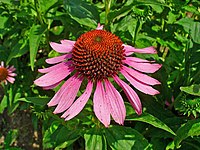
|
|
Echinopsis pachanoi
|
San Pedro cactus
|
The San Pedro cactus contains the entheogen mescaline and has a long history of being used in Andean traditional medicine. |

|
|
Ephedra sinica
|
Ephedra
|
It has been used in traditional Chinese medicine for more than 2,000 years.Native Americans and Mormon pioneers drank a tea brewed from other Ephedra species, called "Mormon tea" and "Indian tea". It contains the alkaloids ephedrine and pseudoephedrine, which are used as breathing aids (bronchodilators and decongestants). |

|
|
Equisetum arvense
|
Horsetail
|
Dates back to ancient Roman and Greek medicine, when it was used to stop bleeding, heal ulcers and wounds, and treat tuberculosis and kidney problems. |

|
|
Eriodictyon crassifolium
|
Yerba Santa
|
Used by the Chumash people to keep airways open for proper breathing. The US Forest Service profile for Eriodictyon crassifolium provides information on species distribution; taxonomic relationships; ecological and evolutionary considerations for restoration; growth form and distinguishing traits; habitat characteristics; projected future suitable habitat; growth, reproduction and dispersal; biological interactions; ecological genetics; seed characteristics, germination requirements and processing; and plant uses including agriculture, restoration, and traditional products, plus an extensive bibliography. It is part of Riverside-Corona Resource Conservation District's resource materials collection on native plant recommendations for southern California ecoregions.
|
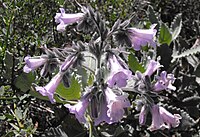
|
|
Erythroxylum coca
|
Coca
|
Used as coca tea or chewed, traditionally as a stimulant to overcome fatigue, hunger, thirst, and altitude sickness. Also used as an anesthetic and analgesic. |

|
|
Eschscholzia californica
|
Californian poppy
|
Used as an herbal remedy: an aqueous extract of the plant has sedative and anxiolytic actions. |
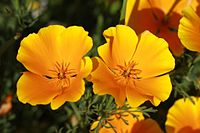
|
|
Eucalyptus globulus
|
Eucalyptus
|
Leaves were widely used in traditional medicine as a febrifuge. Eucalyptus oil is commonly used in over-the-counter cough and cold medications, as well as for an analgesic. |
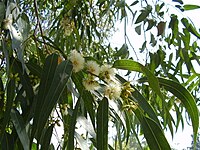
|
|
Euonymus atropurpureus
|
Wahoo
|
Plant is a purgative and might affect the heart. |
|
|
Euphorbia hirta
|
Asthma-plant
|
Used traditionally in Asia to treat bronchitic asthma and laryngeal spasm. It is used in the Philippines for dengue fever. |

|
|
Euphrasia
|
Eyebright
|
Used for eye problems, mental depression, oxygenation and radiation poisoning. |

|
|
Euterpe oleracea
|
Açai
|
Although açai berries are a longstanding food source for indigenous people of the Amazon, there is no evidence that they have effectiveness for any health-related purpose. |
|
F
| Scientific name
|
Name
|
Description
|
Picture
|
|
Ferula assa-foetida
|
Asafoetida
|
Might be useful for IBS, high cholesterol, and breathing problems. |
|
|
Frangula alnus
|
Alder buckthorn
|
Bark (and to a lesser extent the fruit) has been used as a laxative, due to its 3 – 7% anthraquinone content. Bark for medicinal use is dried and stored for a year before use, as fresh bark is violently purgative; even dried bark can be dangerous if taken in excess. |

|
|
Fumaria officinalis
|
Fumitory
|
Traditionally thought to be good for the eyes and to remove skin blemishes. In modern times herbalists use it to treat skin diseases and conjunctivitis, as well as to cleanse the kidneys. However, Howard (1987) warns that fumitory is poisonous and should only be used under the direction of a medical herbalist. |

|
G
| Scientific name
|
Name
|
Description
|
Picture
|
|
Galanthus
|
Snowdrop
|
It contains an active substance called galantamine, which is an acetylcholinesterase inhibitor. Galantamine (or galanthamine) can be helpful in the treatment of Alzheimer's disease, though it is not a cure. |

|
|
Geranium robertianum
|
Robert geranium
|
In traditional herbalism, it was used as a remedy for toothache and nosebleeds and as a vulnerary (used for or useful in healing wounds). |
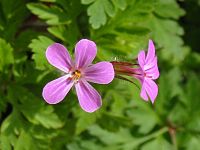
|
|
Ginkgo biloba
|
Ginkgo
|
The leaf extract has been used to treat asthma, bronchitis, fatigue, Alzheimer's and tinnitus. |
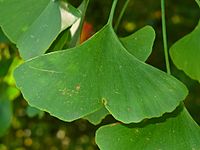
|
|
Glechoma hederacea
|
Ground-ivy
|
It has been used as a "lung herb". Other traditional uses include as an expectorant, astringent, and to treat bronchitis. The essential oil of the plant has been used for centuries as a general tonic for colds and coughs, and to relieve congestion of the mucous membranes.
|
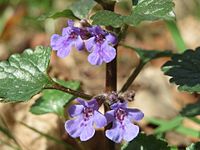
|
|
Glycyrrhiza glabra
|
Licorice root
|
Purported uses include stomach ulcers, bronchitis, and sore throat. |
|
H
I
J
K
| Scientific name
|
Name
|
Description
|
Picture
|
|
Knautia arvensis
|
Field scabious
|
The whole plant is astringent and mildly diuretic. |
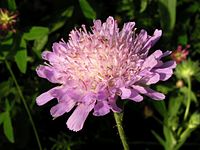
|
L
M
| Scientific name
|
Name
|
Description
|
Picture
|
|
Magnolia officinalis
|
Magnolia-bark
|
The bark contains magnolol and honokiol, two polyphenolic compounds.
|
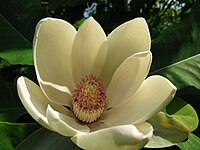
|
|
Malva sylvestris
|
Mallow
|
The seeds are used internally in a decoction or herbal tea as a demulcent and diuretic, and the leaves made into poultices as an emollient for external applications.
|
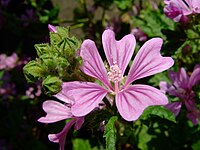
|
|
Matricaria recutita and Anthemis nobilis
|
Chamomile
|
It has been used over history for a variety of conditions, including sleeplessness and anxiety. |

|
|
Medicago sativa
|
Alfalfa
|
The leaves are purported to lower cholesterol, and treat kidney and urinary tract ailments, although there is insufficient scientific evidence for its efficacy. |

|
|
Melaleuca alternifolia
|
Tea tree oil
|
It has been used over history by Australian aboriginal people. Modern usage is primarily as an antibacterial or antifungal agent, but there is insufficient scientific evidence for such effects. |

|
|
Melissa officinalis
|
Lemon balm
|
It is purported as a sleep aid and digestive aid. |
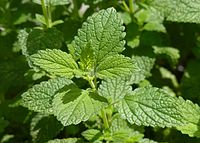
|
|
Mentha x piperita
|
Peppermint
|
Its oil, from a cross between water mint and spearmint, has a history of purported use for various conditions, including nausea, indigestion, and symptoms of the common cold. |

|
|
Mitragyna speciosa
|
Kratom
|
Kratom leaves are chewed to relieve musculoskeletal pain and increase energy, appetite, and sexual desire in ways similar to khat and coca. |
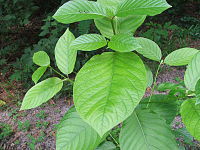
|
|
Momordica charantia
|
Bitter melon
|
|

|
|
Morinda citrifolia
|
Noni
|
It is purported for joint pain and skin conditions. |
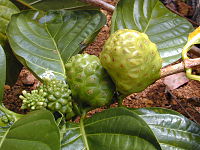
|
|
Moringa oleifera
|
Drumstick tree
|
It is used for food and traditional medicine. |
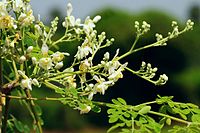
|
N
O
| Scientific name
|
Name
|
Description
|
Picture
|
|
Ocimum tenuiflorum
|
Tulsi or holy basil
|
It is used for a variety of purposes in traditional medicine; tulsi is taken in many forms: as herbal tea, dried powder, fresh leaf or mixed with ghee. Essential oil extracted from Karpoora tulasi is mostly used for medicinal purposes and in herbal cosmetics. |
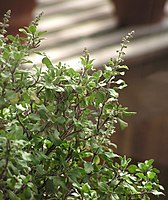
|
|
Oenothera
|
Evening primrose
|
Its oil has been used since the 1930s for eczema, and more recently as an anti-inflammatory, but there is insufficient evidence for it having any effect. |
|
|
Origanum vulgare
|
Oregano
|
|

|
|
P
| Scientific name
|
Name
|
Description
|
Picture
|
|
Panax spec.
|
Ginseng
|
Asian ginseng may affect glucose metabolism and lower blood sugar levels, but the poor quality of research prevents conclusions about such effects. |

|
|
Papaver somniferum
|
Opium poppy
|
The plant is the plant source of morphine, used for pain relief. Morphine made from the refined and modified sap is used for pain control in people with severe cancer. |
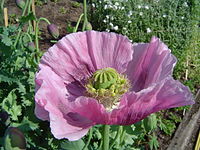
|
|
Passiflora
|
Passion flower
|
|
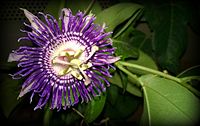
|
|
Peganum harmala
|
Syrian Rue (common name Harmal)
|
|
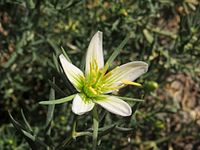
|
|
Pelargonium sidoides
|
Umckaloabo, or South African Geranium
|
Possibly useful for treating respiratory infections. |

|
|
Piper methysticum
|
Kava
|
The plant has been used for centuries in the South Pacific to make a ceremonial drink with sedative and anesthetic properties, with potential for causing liver injury. |

|
|
Piscidia erythrina / Piscidia piscipula
|
Jamaica dogwood
|
The plant is used in traditional medicine for the treatment of insomnia and anxiety, despite serious safety concerns. A 2006 study suggested medicinal potential. |
|
|
Plantago lanceolata
|
Plantain
|
It is used frequently in herbal teas and other herbal remedies. A tea from the leaves is used as a highly effective cough medicine. In the traditional Austrian medicine Plantago lanceolata leaves have been used internally (as syrup or tea) or externally (fresh leaves) for treatment of disorders of the respiratory tract, skin, insect bites, and infections. |
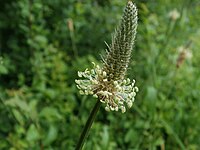
|
|
Platycodon grandiflorus
|
Platycodon, balloon flower
|
The extracts and purified platycoside compounds (saponins) from the roots may exhibit neuroprotective, antimicrobial, anti-inflammatory, anti-cancer, anti-allergy, improved insulin resistance, and cholesterol-lowering properties. |
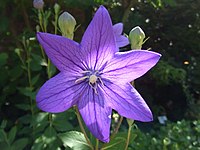
|
|
Polemonium reptans
|
Abscess root
|
It is used to reduce fever, inflammation, and cough. |
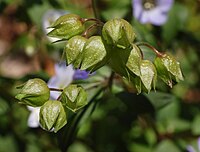
|
|
Psidium guajava
|
Guava
|
It has a rich history of use in traditional medicine. It is traditionally used to treat diarrhea; however, evidence of its effectiveness is very limited. |
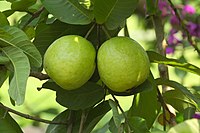
|
|
Ptelea trifoliata
|
Wafer Ash
|
The root bark is used for the digestive system. Also known as hoptree.
|

|
|
Pulmonaria officinalis
|
Lungwort
|
Used since the Middle Ages to treat and/or heal various ailments of the lungs and chest. |

|
Q
| Scientific name
|
Name
|
Description
|
Picture
|
|
Quassia amara
|
Amargo, bitter-wood
|
A 2012 study found a topical gel with 4% Quassia extract to be a safe and effective cure of rosacea. |
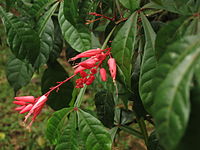
|
R
| Scientific name
|
Name
|
Description
|
Picture
|
|
Reichardia tingitana
|
False sowthistle
|
Uses in folk medicine have been recorded in the Middle East, its leaves being used to treat ailments such as constipation, colic and inflamed eyes. |
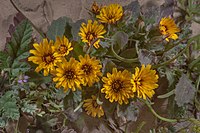
|
|
Rosa majalis
|
Cinnamon rose
|
It yields edible hip fruits rich in vitamin C, which are used in medicine and to produce rose hip syrup.
|
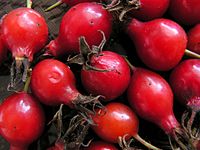
|
|
Rosmarinus officinalis
|
Rosemary
|
It has been used medicinally from ancient times. |

|
|
Ruellia tuberosa
|
Minnieroot, fever root, snapdragon root
|
In folk medicine and Ayurvedic medicine it has been used as a diuretic, anti-diabetic, antipyretic, analgesic, antihypertensive, gastroprotective, and to treat gonorrhea. |

|
|
Rumex crispus
|
Curly dock or yellow dock
|
In Western herbalism the root is often used for treating anemia, due to its high level of iron. The plant will help with skin conditions if taken internally or applied externally to things like itching, scrofula, and sores. It is also used for respiratory conditions, specifically those with a tickling cough that is worse when exposed to cold air. It mentions also passing pains, excessive itching, and that it helps enlarged lymphs. |
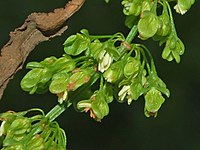
|
S
| Scientific name
|
Name
|
Description
|
Picture
|
|
Salix alba
|
White willow
|
Plant source of salicylic acid, white willow is like the chemical known as aspirin, although more likely to cause stomach upset as a side effect than aspirin itself which can cause the lining of the stomach to be destroyed. Used from ancient times for the same uses as aspirin. |

|
|
Salvia officinalis
|
Sage
|
Shown to improve cognitive function in patients with mild to moderate Alzheimer's disease. |
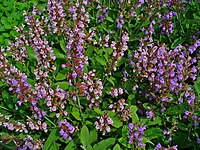
|
|
Sambucus nigra
|
Elderberry
|
The berries and leaves have traditionally been used to treat pain, swelling, infections, coughs, and skin conditions and, more recently, flu, common cold, fevers, constipation, and sinus infections. |

|
|
Santalum album
|
Indian sandalwood
|
Sandalwood oil has been widely used in folk medicine for treatment of common colds, bronchitis, skin disorders, heart ailments, general weakness, fever, infection of the urinary tract, inflammation of the mouth and pharynx, liver and gallbladder complaints and other maladies. |

|
|
Santolina chamaecyparissus
|
Cotton lavender
|
Most commonly, the flowers and leaves are made into a decoction used to expel intestinal parasites. |

|
|
Saraca indica
|
Ashoka tree
|
The plant is used in Ayurvedic traditions to treat gynecological disorders. The bark is also used to combat oedema or swelling. |

|
|
Satureja hortensis
|
Summer savory
|
Its extracts show antibacterial and antifungal effects on several species including some of the antibiotic resistant strains. |
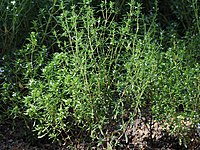
|
|
Sceletium tortuosum
|
Kanna
|
African treatment for depression. Suggested to be an SSRI or have similar effects, but unknown mechanism of activity. |

|
|
Senna auriculata
|
Avaram senna
|
The root is used in decoctions against fevers, diabetes, diseases of urinary system and constipation. The leaves have laxative properties. The dried flowers and flower buds are used as a substitute for tea in case of diabetes patients. The powdered seed is also applied to the eye, in case of chronic purulent conjunctivitis. |
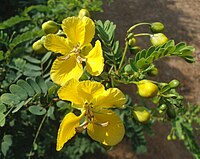
|
|
Sesuvium portulacastrum
|
Shoreline purslane
|
The plant extract showed antibacterial and anticandidal activities and moderate antifungal activity. |
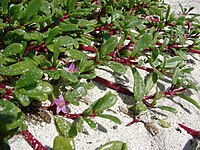
|
|
Silybum marianum
|
Milk thistle
|
It has been used for thousands of years for a variety of medicinal purposes, in particular liver problems. |
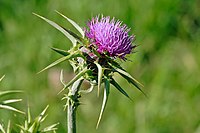
|
|
Stachytarpheta cayennensis
|
Blue snakeweed
|
Extracts of the plant are used to ease the symptoms of malaria. The boiled juice or a tea made from the leaves or the whole plant is taken to relieve fever and other symptoms. It is also used for dysentery, pain, and liver disorders. A tea of the leaves is taken to help control diabetes in Peru and other areas. Laboratory tests indicate that the plant has anti-inflammatory properties. |
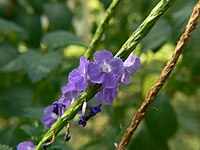
|
|
Stellaria media
|
Common chickweed
|
It has been used as a remedy to treat itchy skin conditions and pulmonary diseases. 17th century herbalist John Gerard recommended it as a remedy for mange. Modern herbalists prescribe it for iron-deficiency anemia (for its high iron content), as well as for skin diseases, bronchitis, rheumatic pains, arthritis and period pain. |
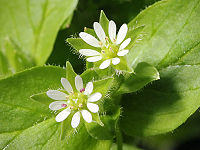
|
|
Strobilanthes callosus
|
Karvy
|
The plant is anti-inflammatory, antimicrobial, and anti-rheumatic. |
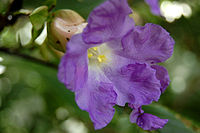
|
|
Symphytum officinale
|
Comfrey
|
It has been used as a vulnerary and to reduce inflammation. It was also used internally in the past, for stomach and other ailments, but its toxicity has led a number of other countries, including Canada, Brazil, Australia, and the United Kingdom, to severely restrict or ban the use of comfrey. |

|
|
Syzygium aromaticum
|
Clove
|
The plant is used for upset stomach and as an expectorant, among other purposes. The oil is used topically to treat toothache. |

|
T
| Scientific name
|
Name
|
Description
|
Picture
|
|
Tanacetum parthenium
|
Feverfew
|
The plant has been used for centuries for fevers, headaches, stomach aches, toothaches, insect bites and other conditions. |

|
|
Taraxacum officinale
|
Dandelion
|
It was most commonly used historically to treat liver diseases, kidney diseases, and spleen problems. |

|
|
Teucrium scordium
|
Water germander
|
It has been used for asthma, diarrhea, fever, intestinal parasites, hemorrhoids, and wounds. |
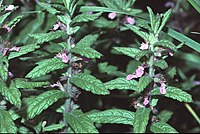
|
|
Thymus vulgaris
|
Thyme
|
The plant is used to treat bronchitis and cough. It serves as an antispasmodic and expectorant in this role. It has also been used in many other medicinal roles in Asian and Ayurvedic medicine, although it has not been shown to be effective in non-respiratory medicinal roles. |
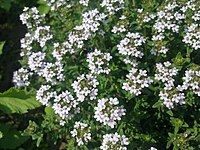
|
|
Tilia cordata
|
Small-leaved linden
|
In the countries of Central, Southern and Western Europe, linden flowers are a traditional herbal remedy made into an herbal tea called tisane. |

|
|
Tradescantia zebrina
|
Inchplant
|
It is used in southeast Mexico in the region of Tabasco as a cold herbal tea, which is named Matali.Skin irritation may result from repeated contact with or prolonged handling of the plant, particularly from the clear, watery sap (a characteristic unique to T. zebrina as compared with other types).
|
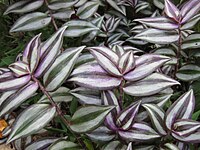
|
|
Trema orientalis
|
Charcoal-tree
|
The leaves and the bark are used to treat coughs, sore throats, asthma, bronchitis, gonorrhea, yellow fever, toothache, and as an antidote to general poisoning. |
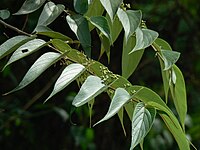
|
|
Trifolium pratense
|
Red clover
|
The plant is an ingredient in some recipes for essiac tea. Research has found no benefit for any human health conditions. |

|
|
Trigonella foenum-graecum
|
Fenugreek
|
It has long been used to treat symptoms of menopause, and digestive ailments. More recently, it has been used to treat diabetes, loss of appetite and other conditions. |
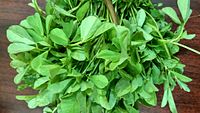
|
|
Triticum aestivum
|
Wheatgrass
|
It may contain antioxidant and anti-inflammatory compounds. |

|
|
Turnera subulata
|
White buttercup
|
It is used for skin, gastrointestinal, and respiratory ailments. |
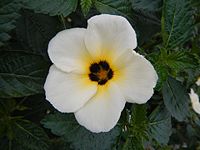
|
U
| Scientific name
|
Name
|
Description
|
Picture
|
|
Uncaria tomentosa
|
Cat's claw
|
It has a long history of use in South America to prevent and treat disease. |
|
|
Urtica dioica
|
Common nettle, stinging nettle
|
It has been used in the traditional Austrian medicine internally (as tea or fresh leaves) to treat disorders of the kidneys and urinary tract, gastrointestinal tract, locomotor system, skin, cardiovascular system, hemorrhage, influenza, rheumatism, and gout. |
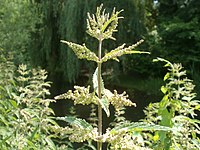
|
V
| Scientific name
|
Name
|
Description
|
Picture
|
|
Vaccinium spec.
|
Blueberries
|
They are of current medical interest as an antioxidant and for urinary tract ailments. |

|
|
Vaccinium macrocarpon
|
Cranberry
|
It was used historically as a vulnerary and for urinary disorders, diarrhea, diabetes, stomach ailments, and liver problems. Modern usage has concentrated on urinary tract related problems. |
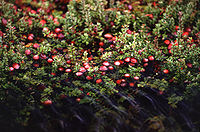
|
|
Vaccinium myrtillus
|
Bilberry
|
It is used to treat diarrhea, scurvy, and other conditions. |
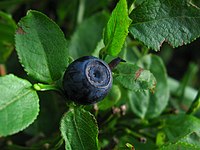
|
|
Valeriana officinalis
|
Valerian
|
It has been used since at least ancient Greece and Rome for sleep disorders and anxiety. |
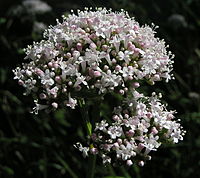
|
|
Verbascum thapsus
|
Common mullein
|
It contains glycyrrhizin compounds with bactericide and potential anti-tumoral action. These compounds are concentrated in the flowers. |

|
|
Verbena officinalis
|
Verbena
|
It is used for sore throats and respiratory tract diseases. |
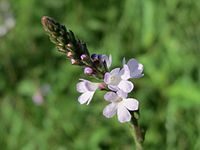
|
|
Vernonia amygdalina
|
Bitter leaf
|
The plant is used by both primates and indigenous peoples in Africa to treat intestinal ailments such as dysentery. |

|
|
Veronica officinalis
|
Veronica
|
The plant is used for sinus and ear infections. |
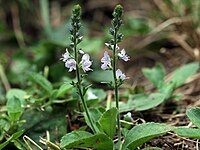
|
|
Viburnum tinus
|
Laurustinus
|
V. tinus has medicinal properties. The active ingredients are viburnin (a substance or more probably a mixture of compounds) and tannins. Tannins can cause stomach upset. The leaves when infused have antipyretic properties. The fruits have been used as purgatives against constipation. The tincture has been used lately in herbal medicine as a remedy for depression. The plant also contains iridoid glucosides. |
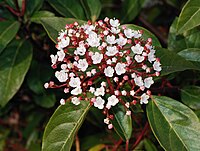
|
|
Viola tricolor
|
Wild pansy
|
It is one of many viola plant species containing cyclotides. These small peptides have proven to be useful in drug development due to their size and structure giving rise to high stability. Many cyclotides, found in Viola tricolor are cytotoxic. This feature means that it could be used to treat cancers. |

|
|
Viscum album
|
European mistletoe
|
It has been used to treat seizures, headaches, and other conditions. |
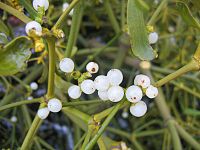
|
|
Vitex agnus-castus
|
Chasteberry
|
It has been used for over thousands of years for menstrual problems, and to stimulate lactation. |
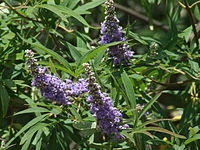
|
|
Vitis vinifera
|
Grape
|
The leaves and fruit have been used medicinally since the ancient Greeks. |

|
W
| Scientific name
|
Name
|
Description
|
Picture
|
|
Withania somnifera
|
Ashwagandha
|
The plant's long, brown, tuberous roots are used in traditional medicine. In Ayurveda, the berries and leaves are applied externally to tumors, tubercular glands, carbuncles, and ulcers. |
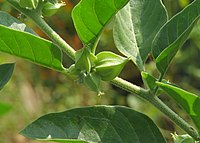
|
X
| Scientific name
|
Name
|
Description
|
Picture
|
|
Xanthoparmelia scabrosa
|
Sexy footpath lichen
|
It is a lichen used for sexual dysfunction. |

|
Y
Z
Databases
See also
-
^ Digitalis use in the United States is controlled by the U.S. Food and Drug Administration and can only be prescribed by a physician. Misuse can cause death.
- This encyclopedia is not a substitute for medical advice nor a complete description of these herbs, their dangers (up to and including death), and their (in)compatibility with alcohol or other drugs.
Further reading
External links
-
 The dictionary definition of herbalism at Wiktionary
The dictionary definition of herbalism at Wiktionary
-
 Media related to Herbalism at Wikimedia Commons
Media related to Herbalism at Wikimedia Commons
|
Medicinal herbs and fungi
|
|---|
| Herbs |
|
| Fungi |
|
| Regional practices |
|
| Related subjects |
|
|




























































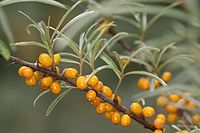









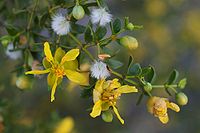


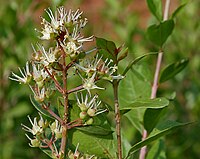

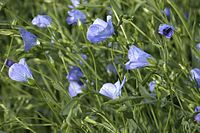











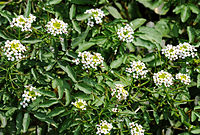
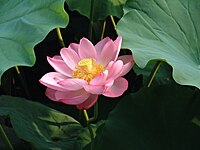
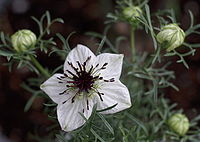
































































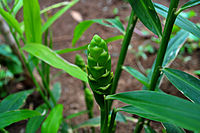
 The dictionary definition of herbalism at Wiktionary
The dictionary definition of herbalism at Wiktionary Media related to Herbalism at Wikimedia Commons
Media related to Herbalism at Wikimedia Commons